“I’m often asked by senior leaders in different organisations how they should measure software delivery, and kickstart a Continuous Delivery culture. Accelerate and Measuring Continuous Delivery have some of the answers, but not all of them.
This for anyone wondering how to effectively measure Product, Delivery, and Operations teams as one, in their own organisation…”
Steve Smith
TL;DR:
- Teams working in an IT cost centre are often judged on vanity measures such as story points and incident count.
- Teams need to be measured on outcomes linked to business goals, deployment throughput, and availability.
- A product manager, not a delivery lead or tech lead, must be accountable for all target measures linked to a product and the teams working on it.
Introduction
In A Typology of Organisational Cultures, Ron Westrum defines culture as power, rule, or performance-oriented. An organisation in a state of Discontinuous Delivery has a power or rule-oriented culture, in which bridging between teams is discouraged or barely tolerated.
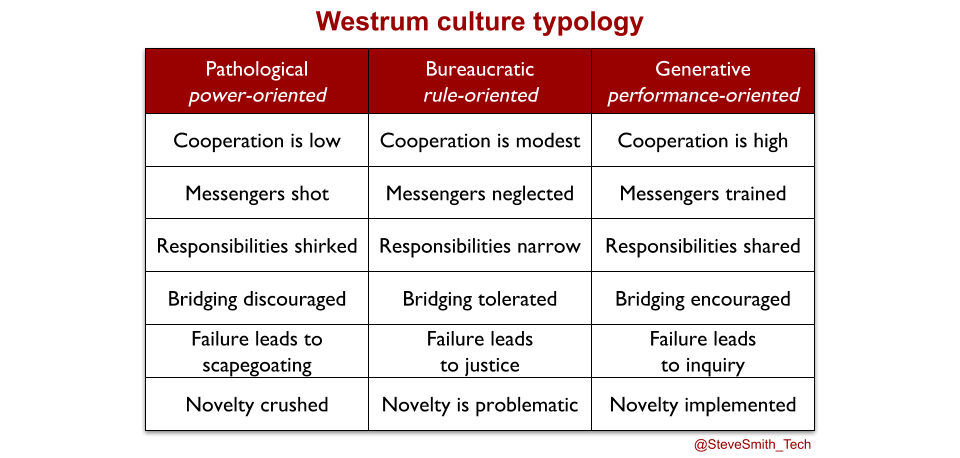
A majority of organisations mired in Discontinuous Delivery have IT as a Cost Centre. Their value streams crosscut siloed organisational functions in Product, Delivery, and Operations. Each silo has its own target measures, which reinforce a power or rule-oriented culture. Examples include page views and revenue per customer in Product, story points and defect counts in Delivery, and incident counts and server uptime in Operations.
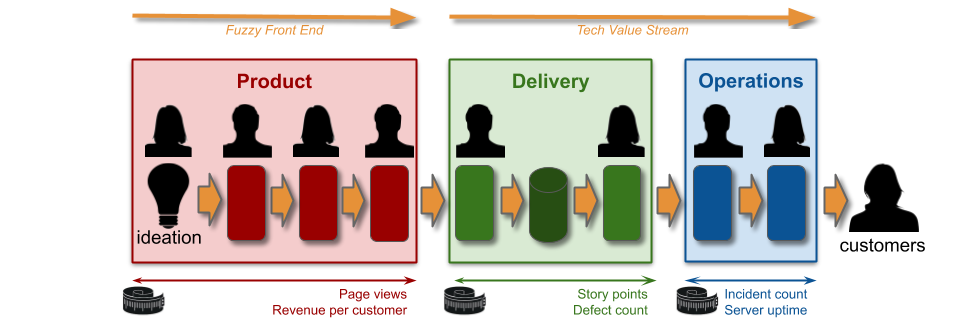
These are vanity measures. A vanity measure in a value stream is an output of one or a few siloed activities, in a single organisational function. As a target, it is vulnerable to individual bias, under-reporting, and over-reporting by people within that silo, due to Goodhart’s Law. Vanity measures have an inherently low information value, and incentivise people in different silos to work at cross-purposes.
Measure outcomes, not outputs
Measuring Continuous Delivery by the author describes how an organisation can transition from Discontinuous Delivery to Continuous Delivery, and dramatically improve service throughput and reliability. A performance-oriented culture needs to be introduced, in which bridging between teams is encouraged.
The first step in that process is to replace vanity measures with actionable measures. An actionable measure in a value stream is a holistic outcome for all activities. It has a high information value. It has some protection against individual bias, under-reporting, and over-reporting, because it is spread across all organisational functions.
Actionable measures for customer success could include conversion rate, and customer lifetime value. Accelerate by Dr Nicole Forsgren et al details the actionable measures for service throughput:
- Deployment frequency. The time between production deployments.
- Deployment lead time. The time between a mainline code commit and its deployment.
Accelerate does not extend to service reliability. The actionable measures of service reliability are availability rate, and time to restore availability.
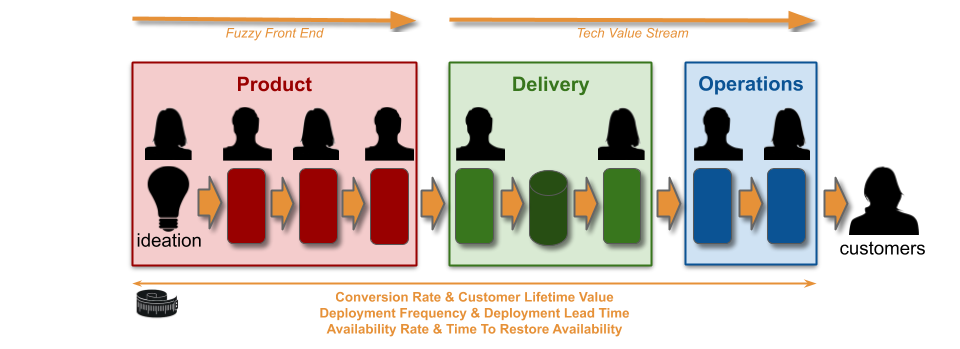
Target measures for service throughput and reliability need to be set for services at the start of a Continuous Delivery programme. They increase information flow, cooperation, and trust between people, teams, and organisational functions within the same value stream. They make it clear the product manager, delivery team, and operations team working on the same service share a responsibility for its success. It is less obvious who is accountable for choosing the target measures, and ensuring they are met.
Avoid delivery tech lead accountability
One way to approach target accountability is for a product manager to be accountable for a deployment frequency target, and a delivery tech lead accountable for a deployment lead time target. This is based on deployment lead time correlating with technical quality, and its reduction depending on delivery team ownership of the release process.
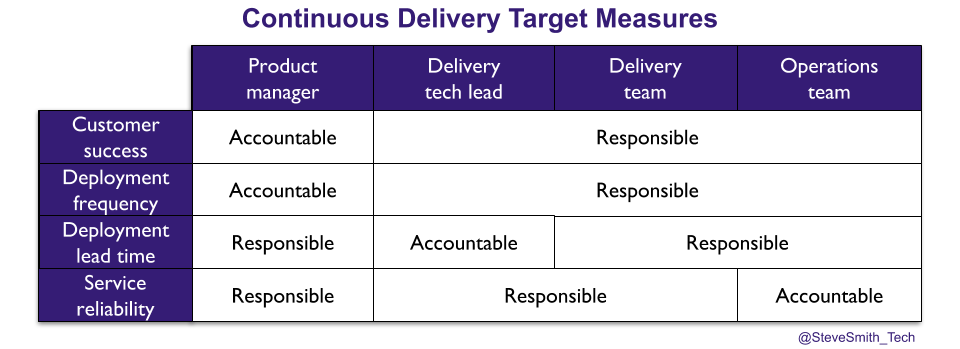
It is true that Continuous Delivery is predicated on a delivery team gradually assuming sole ownership of the release process, and fully automating it as a deployment pipeline. However, the argument for delivery tech lead accountability is flawed, due to:
- Process co-ownership. The release process is co-owned by delivery and operations teams at the outset, while it is manual or semi-automated. A delivery tech lead cannot be accountable for a team in another organisational function.
- Limited influence. An operations team is unlikely to be persuaded by a delivery tech lead that release activities move to a delivery team for automation. A delivery tech lead is not influential in other organisational functions.
- Prioritisation conflict. The product manager and delivery tech lead have separate priorities, for product features and deployment lead time experiments. A delivery tech lead cannot compete with a product manager prioritising product features on their own.
- Siloed accountabilities. A split in throughput target accountability perpetuates the Product and IT divide. A delivery tech lead cannot force a product manager to be invested in deployment lead time.
Maximise product manager accountability
In a power or rule-oriented culture, driving change across organisational functions requires significant influence. The most influential person across Product, Delivery, and Operations for a service will be its budget holder, and that is the product manager. They will be viewed as the sponsor for any improvement efforts related to the service. Their approval will lend credibility to changes, such as a delivery team owning and automating the release process.
Product managers should be accountable for all service throughput and reliability targets. It will encourage them to buy into Continuous Delivery as the means to achieve their product goals. It will incentivise them to prioritise deployment lead time experiments and operational features alongside product features. It will spur them to promote change across organisational functions.
In The Decision Maker, Dennis Bakke advocates effective decision making as a leader choosing a decision maker, and the decision maker gathering information before making a decision. A product manager does not have to choose the targets themselves. If they wish, they can nominate their delivery tech lead to gather feedback from different people, and then make a decision for which the product manager is accountable. The delivery and operations teams are then responsible for delivering the service, with sufficient technical discipline and engineering skills to achieve those targets.
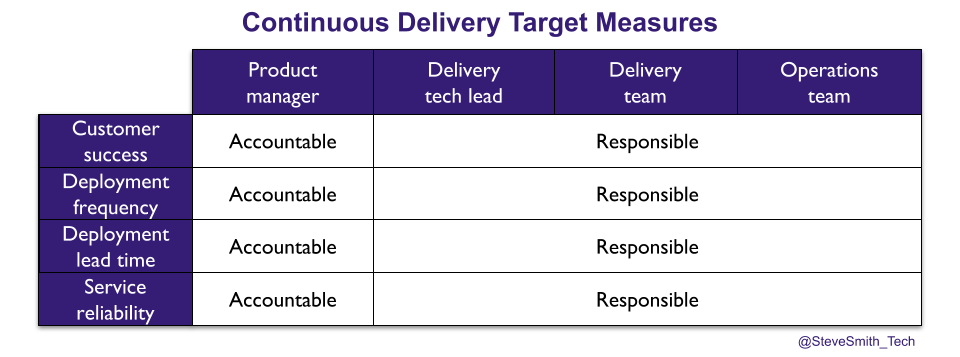
A product manager may be uncomfortable with accountability for IT activities. The multi-year research data in Accelerate is clear of the business benefits for a faster deployment lead time:
- Less rework. The ability to quickly find defects in automated tests tightens up feedback cycles, which reduces rework and accelerates feature development.
- More revenue protection. Using the same deployment pipeline to restore lost availability, or apply a security patch in minutes, limits revenue losses and reputational damage on failure.
- Customer demand potential. A deployment lead time that is a unit of time less than deployment frequency demonstrates an ability to satisfy more demand, if it can be unlocked.
Summary
Adopting Continuous Delivery is based on effective target measures of service throughput and reliability. Establishing the same targets across all the organisational functions in a value stream will start the process of nudging the organisational culture from power or rule-oriented to performance-oriented. The product manager should be accountable for all target measures, and the delivery and operations teams responsible for achieving them.
It will be hard. There will be authoritative voices in different organisational functions, with a predisposition to vanity measures. The Head of Product, Head of Delivery, and Head of Operations might have competing budget priorities, and might not agree on the same target measures. Despite these difficulties, it is vital the right target measures are put in place. As Peter Drucker said in The Essential Drucker, ‘if you want something new, you have to stop doing something old’.
Acknowledgements
Thanks to Charles Kubicek, Dave Farley, Phil Parker, and Thierry de Pauw for their feedback.